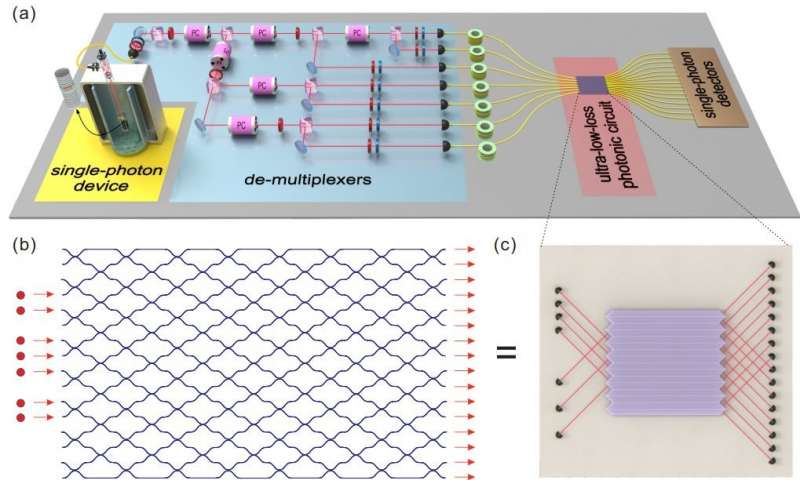
A team of researchers from China, Germany and the U.S. has found that boson sampling with photons is a viable option for testing for quantum supremacy, despite photons leaking from a given test system. In their paper published in the journal Physical Review Letters, the group describes testing the idea using photons emitted from a quantum dot.
In the computer world, proving that a quantum computer will always outperform a classical machine when working on certain difficult problems is known as quantum supremacy. But as work progresses towards the development of a truly useful quantum computer, scientists continue to push the limits of traditional computers. As a result, researchers are exploring how to design and develop proper tests for comparing the types of architectures. In this new effort, the researchers looked into the idea of boson sampling with photons as a test for both machine types. Prior research on the idea suggested it would not be useful because of problems arising from photons leaking from the system.
The boson-sampling system scenario works by creating an environment where photons are introduced into a device for a given period of time and are allowed to interact—measurements are taken of their positions during the same time period. The idea is to simulate the distribution of the location of the photons over multiple samples, a chore that prior research has suggested would take exponentially longer on today’s computers compared to quantum machines due to the necessity of factoring for the random interactions that occur. The fear was that photons lost due to leakage would make such an approach impractical for testing quantum supremacy.
To test the idea, the researchers set up a physical device—a semiconductor quantum dot inside of a cavity. The dot served as a virtual atom—it emitted photons (bosons) when shot by a laser. Those photons were then sent through an array of optical objects that caused them to take multiple pathways, generating a virtual network. A photon detector was placed at all of the exits for the purpose of noting their positions. The researchers found that many of the “lost photon” samples were actually useful, which led to improvement in the data acquisition rate. And that showed that the idea should be a feasible approach for testing quantum supremacy.
Abstract
Boson sampling is a well-defined task that is strongly believed to be intractable for classical computers, but can be efficiently solved by a specific quantum simulator. However, an outstanding problem for large-scale experimental boson sampling is the scalability. Here we report an experiment on boson sampling with photon loss, and demonstrate that boson sampling with a few photons lost can increase the sampling rate. Our experiment uses a quantum-dot-micropillar single-photon source demultiplexed into up to seven input ports of a 16*16 mode ultra-low-loss photonic circuit, and we detect three-, four- and five-fold coincidence counts. We implement and validate lossy boson sampling with one and two photons lost, and obtain sampling rates of 187 kHz, 13.6 kHz, and 0.78 kHz for five-, six- and seven-photon boson sampling with two photons lost, which is 9.4, 13.9, and 18.0 times faster than the standard boson sampling, respectively. Our experiment shows an approach to significantly enhance the sampling rate of multiphoton boson sampling.